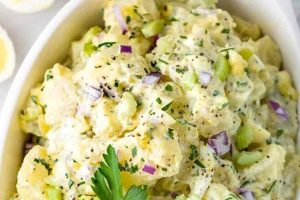A dish featuring cooked potatoes combined with a mustard-based dressing constitutes a classic picnic and barbecue staple. Variations exist, incorporating ingredients such as celery, onions, hard-boiled eggs, and pickles, offering diverse flavor profiles. Documentation of potato salad recipes dates back centuries, adapting and evolving across different cultures and culinary traditions.
This culinary creation offers a balance of creamy, tangy, and savory flavors, making it a versatile side dish. Its adaptability allows for customization to suit individual preferences and dietary needs, with options for vegan, low-fat, or gluten-free versions. Furthermore, its make-ahead nature contributes to its popularity for gatherings and potlucks, allowing for convenient preparation and serving.
The following sections will delve into specific ingredient selections, preparation techniques, and variations for crafting this popular dish, offering guidance for both novice and experienced cooks. Considerations for ingredient sourcing, storage, and presentation will also be addressed.
Tips for Mustard Potato Salad Preparation
Achieving a well-balanced and flavorful mustard potato salad requires attention to detail throughout the preparation process. The following tips offer guidance for optimal results.
Tip 1: Potato Selection and Cooking: Opting for waxy potatoes, such as Yukon Gold or red potatoes, ensures they hold their shape after cooking. Overcooking should be avoided to prevent a mushy texture.
Tip 2: Mustard Selection: Experimenting with different mustard varieties, like Dijon, stone-ground, or whole-grain, allows for customized flavor profiles. A combination of mustards can add complexity.
Tip 3: Dressing Emulsification: A stable emulsion prevents the dressing from separating. Whisking the mustard with vinegar and oil creates a cohesive texture that coats the potatoes evenly.
Tip 4: Ingredient Incorporation: Adding the dressing while the potatoes are still slightly warm allows for better absorption of flavor. Gentle mixing prevents the potatoes from breaking down.
Tip 5: Flavor Balancing: Acidity plays a crucial role in balancing the richness of the potatoes and the sharpness of the mustard. Adjusting vinegar or lemon juice levels achieves the desired balance.
Tip 6: Chilling and Serving: Chilling the salad allows the flavors to meld. Serving the salad chilled enhances the overall taste and texture.
Tip 7: Garnish and Presentation: Fresh herbs, such as chives or parsley, add visual appeal and a burst of freshness. Consider adding a sprinkle of paprika or a few capers for a finishing touch.
By adhering to these guidelines, one can achieve a flavorful and well-textured mustard potato salad. Careful attention to ingredient selection, preparation techniques, and flavor balancing contribute to a satisfying culinary experience.
By understanding these elements, one can create a dish that complements a variety of meals and satisfies diverse palates. The subsequent sections will provide specific recipe examples and further explore variations on this classic dish.
1. Potato Variety
Potato variety significantly influences the texture and overall success of mustard potato salad. Starchy potatoes, such as russets, tend to absorb more water during cooking and can become overly soft, resulting in a mushy salad. Waxy potatoes, including Yukon Gold and red potatoes, hold their shape better after boiling, contributing to a firmer, more desirable texture. This characteristic allows the potatoes to absorb the dressing without disintegrating, maintaining distinct pieces within the salad.
Choosing the correct potato variety demonstrates an understanding of the desired final product. For example, a classic American-style potato salad benefits from the firm texture of red potatoes, allowing them to stand up to the creamy dressing. Conversely, a German potato salad, often served warm with a vinegar-based dressing, might utilize a slightly starchier potato that can absorb more of the tangy liquid. The interplay between potato variety and dressing type is crucial for achieving the intended flavor and textural balance.
Selecting an appropriate potato variety is fundamental to a successful mustard potato salad. Understanding the differences between starchy and waxy potatoes ensures a final product with the desired textural qualities. This seemingly simple choice significantly impacts the overall enjoyment of the dish, highlighting the importance of ingredient selection in culinary endeavors. Neglecting this aspect can lead to a less satisfying experience, underscoring the need for informed decision-making when preparing this classic dish.
2. Mustard Type
Mustard type plays a critical role in defining the flavor profile of mustard potato salad. The choice of mustard influences not only the overall taste but also the texture and complexity of the dish. Understanding the nuances of various mustard varieties allows for informed decision-making when crafting a recipe.
- Dijon Mustard
Dijon mustard, known for its smooth texture and tangy flavor, offers a classic foundation for potato salad. Its pronounced acidity balances the richness of the potatoes and other ingredients. The subtle heat and depth of flavor characteristic of Dijon mustard add complexity without overpowering the other components of the salad.
- Yellow Mustard
Yellow mustard, a milder and slightly sweeter option, provides a familiar flavor profile. While less complex than Dijon, yellow mustard offers a readily available and versatile base for the dressing. Its bright color contributes to the visual appeal of the finished dish. Its mildness makes it a suitable choice for those who prefer a less assertive mustard flavor.
- Stone-Ground Mustard
Stone-ground mustard, with its coarsely textured consistency and robust flavor, introduces a rustic element. The visible mustard seeds add textural interest to the salad. The intense flavor, often incorporating spices and herbs, provides a bolder dimension compared to smoother mustards. This choice adds a pronounced mustard presence to the dish.
- Whole-Grain Mustard
Whole-grain mustard combines the robust flavor of stone-ground mustard with a slightly smoother texture. The presence of whole mustard seeds offers a textural component while maintaining a degree of creaminess. This type of mustard provides a balance between the intensity of stone-ground and the smoothness of Dijon, offering a versatile option for mustard potato salad.
The selected mustard type ultimately shapes the character of the potato salad. From the smooth tang of Dijon to the robust bite of stone-ground, each variety imparts unique characteristics. Careful consideration of these nuances allows for the creation of a customized flavor profile tailored to individual preferences. The interplay between mustard, potatoes, and other ingredients contributes to a complex and satisfying culinary experience, emphasizing the significant impact of mustard selection in crafting a well-balanced and flavorful potato salad.
3. Dressing Consistency
Dressing consistency significantly impacts the overall quality and enjoyment of mustard potato salad. A dressing that is too thin fails to adhere properly to the potatoes, resulting in a watery, less flavorful dish. Conversely, an excessively thick dressing can become heavy and overwhelm the delicate balance of flavors. The ideal consistency lies in a smooth, emulsified state that coats the potatoes evenly, allowing the flavors to meld and enhance the overall culinary experience. Achieving the proper consistency involves careful consideration of the ratio of oil to vinegar, as well as the emulsification process itself. A properly emulsified dressing not only enhances flavor distribution but also contributes to the visual appeal of the salad, creating a cohesive and appetizing presentation.
Consider a scenario where a thin, watery dressing is used. The dressing will likely pool at the bottom of the serving dish, leaving the potatoes inadequately coated and lacking in flavor. The potatoes may also become dry and unappetizing. In contrast, an overly thick dressing might clump and cling unevenly to the potatoes, creating an unpleasant textural experience. The thick dressing could also mask the subtle flavors of the other ingredients, resulting in a less nuanced dish. A real-world example of achieving the correct consistency involves whisking together oil and vinegar slowly while gradually adding the mustard. This method promotes a stable emulsion, preventing the dressing from separating and ensuring a smooth, creamy texture that clings evenly to the potatoes. This careful attention to the emulsification process yields a dressing that not only enhances flavor but also contributes to the overall aesthetic appeal of the salad.
Understanding the importance of dressing consistency allows for the creation of a superior mustard potato salad. A well-emulsified dressing ensures proper flavor distribution, enhances textural appeal, and contributes to the overall presentation of the dish. Achieving this balance requires attention to detail during the preparation process, specifically focusing on the emulsification of oil, vinegar, and mustard. This understanding enables one to create a potato salad that is not only flavorful but also visually appealing, maximizing the enjoyment of this classic dish. Mastery of this aspect elevates the final product from merely acceptable to truly exceptional, highlighting the crucial role of dressing consistency in crafting a high-quality mustard potato salad.
4. Added Ingredients
Added ingredients represent a pivotal aspect of mustard potato salad, contributing significantly to its flavor profile, textural complexity, and overall appeal. These additions move beyond the core components of potatoes and mustard dressing, offering opportunities for customization and culinary creativity. Careful selection and balanced incorporation of added ingredients elevate this classic dish from simple to exceptional. The interplay between these additions and the foundational elements determines the final character of the salad, influencing its suitability for various occasions and palates.
Consider the addition of hard-boiled eggs. The yolks contribute a creamy richness that complements the tangy mustard, while the whites offer a contrasting textural element. Chopped celery introduces a crisp, refreshing counterpoint to the soft potatoes, enhancing the overall sensory experience. Sweet pickle relish adds a touch of sweetness and acidity, balancing the savory notes of the mustard and potatoes. These examples illustrate how strategically chosen additions can enhance the complexity and balance of the salad. Furthermore, the choice of added ingredients can reflect regional preferences and culinary traditions. For example, a German potato salad might incorporate bacon and onions, while an American-style version might feature celery seed and paprika. These variations highlight the adaptability of mustard potato salad and its capacity to accommodate diverse flavor profiles.
Understanding the role of added ingredients in mustard potato salad empowers culinary exploration and customization. It allows for the creation of unique flavor combinations tailored to individual preferences and dietary needs. Awareness of ingredient interactions and balanced incorporation prevents overpowering the core elements of potatoes and mustard, ensuring a harmonious final product. The practical application of this knowledge transforms the preparation of mustard potato salad from a rote exercise into an opportunity for culinary expression. The thoughtful selection and balanced incorporation of added ingredients ultimately elevates this humble dish, showcasing its versatility and enduring appeal.
5. Seasoning Balance
Seasoning balance represents a critical factor in a successful mustard potato salad recipe. It directly impacts the overall flavor profile and enjoyment of the dish. A harmonious blend of seasonings elevates the inherent flavors of the core ingredientspotatoes and mustardwithout any single element overpowering the others. This balance differentiates a bland, forgettable salad from a vibrant, flavorful one. Achieving this equilibrium requires careful consideration of salt, acidity, sweetness, and spices.
- Salt
Salt acts as a flavor enhancer, accentuating the natural sweetness of the potatoes and the tanginess of the mustard. Under-salting results in a flat, unappealing taste, while over-salting can obscure the other flavors and render the salad inedible. A real-world example involves dissolving salt in the warm cooking water for the potatoes, ensuring even seasoning throughout. Adding a small amount of salt directly to the dressing further refines the flavor balance. This dual approach ensures optimal salinity throughout the dish.
- Acidity
Acidity, typically derived from vinegar or lemon juice, provides brightness and balances the richness of the potatoes and the sharpness of the mustard. Insufficient acidity results in a dull, heavy salad, whereas excessive acidity can create an overly tart flavor. In practical application, tasting the dressing and adjusting the vinegar or lemon juice accordingly ensures the desired balance. This iterative process allows for precise calibration based on the specific ingredients used.
- Sweetness
Sweetness, often introduced through the addition of sweet pickle relish or a touch of sugar, adds depth and complexity to the flavor profile. This sweetness counterbalances the acidity and the savory notes, creating a more well-rounded flavor. However, excessive sweetness can mask the other flavors and create an unbalanced profile. A real-world scenario involves starting with a small amount of sweet pickle relish and adjusting based on personal preference. This measured approach avoids over-sweetening.
- Spices
Spices, such as celery seed, paprika, or black pepper, contribute nuanced layers of flavor and aroma. These additions can complement the other seasonings and further enhance the complexity of the salad. Overuse, however, can overwhelm the delicate balance and create a muddled flavor profile. Practical application involves adding spices sparingly, tasting, and adjusting as needed. This method ensures that the spices enhance rather than dominate the overall flavor.
Achieving optimal seasoning balance in mustard potato salad involves a dynamic interplay between these four elements. The precise ratios depend on the specific ingredients used and individual preferences. Its a process of continuous adjustment and refinement, guided by careful tasting and a nuanced understanding of flavor interactions. A well-seasoned mustard potato salad exemplifies the transformative power of balance, elevating a simple dish to a culinary delight. This careful attention to detail distinguishes an average potato salad from a truly exceptional one.
6. Chilling Time
Chilling time plays a crucial role in the development of flavor and texture in mustard potato salad. Allowing the salad to rest in refrigeration for a period, ideally a minimum of two hours, enables the flavors of the various componentspotatoes, mustard, other ingredients, and seasoningsto meld and harmonize. This melding process creates a more cohesive and complex flavor profile compared to a freshly made, unchilled salad. Furthermore, chilling firms the potatoes, enhancing their textural appeal and contributing to a more satisfying culinary experience. This effect is particularly noticeable with waxy potatoes, which maintain their structural integrity better after chilling. A real-world example involves preparing the potato salad the day before a picnic or gathering. This advance preparation not only simplifies serving but also allows ample chilling time for optimal flavor development and textural enhancement. Neglecting the chilling process compromises the overall quality of the dish, resulting in a less flavorful and potentially less appealing salad.
The chemical processes occurring during chilling contribute significantly to the observed flavor enhancement. As the salad rests, the flavors of the individual ingredients diffuse and interact, creating new flavor compounds and a more integrated taste experience. The lower temperature also slows down enzymatic activity within the potatoes, helping to preserve their texture and prevent them from becoming mushy. Practical applications of this understanding include adjusting the chilling time based on the specific recipe and desired outcome. For instance, a potato salad with bolder flavors, such as those incorporating strong cheeses or pickled ingredients, might benefit from a longer chilling period to allow the flavors to fully integrate. Conversely, a simpler salad with milder flavors might require a shorter chilling time. Understanding these nuances empowers one to tailor the chilling process for optimal results.
In conclusion, chilling time represents a fundamental yet often overlooked step in preparing mustard potato salad. It is not merely a matter of convenience but rather a critical factor influencing both flavor and texture. The practical application of this knowledge, including adjusting chilling time based on recipe specifics and desired outcomes, elevates the final product from simply adequate to truly exceptional. Recognizing the impact of chilling ensures a more satisfying culinary experience, highlighting the importance of this often-underestimated element in crafting a superior mustard potato salad. Failure to appreciate the significance of chilling can compromise the overall quality of the dish, underscoring the need for informed preparation techniques.
7. Serving Suggestions
Serving suggestions provide crucial context for a recipe mustard potato salad, transforming it from a standalone dish into a versatile component of a broader culinary experience. These suggestions illuminate the potential of the salad within various meal structures and occasions, enhancing its perceived value and broadening its appeal. A well-crafted set of serving suggestions elevates a basic recipe by demonstrating its adaptability and integration within diverse dining contexts. Consider the difference between simply presenting a recipe and suggesting its pairing with grilled meats, incorporation into a buffet spread, or presentation as a light lunch alongside a sandwich. These suggestions provide practical applications for the recipe, inspiring cooks to explore its versatility and maximize its potential. Without serving suggestions, a recipe, regardless of its inherent quality, risks being perceived as isolated and lacking in broader culinary relevance.
Practical examples further illustrate this connection. A mustard potato salad recipe might recommend serving it chilled as a side dish for barbecued ribs, highlighting the textural and flavor contrast between the creamy salad and the smoky, tender meat. Alternatively, the recipe might suggest incorporating the salad into a picnic basket alongside sandwiches and fresh fruit, emphasizing its portability and suitability for outdoor dining. For a lighter meal, the recipe might propose serving smaller portions of the potato salad alongside grilled fish or chicken, positioning it as a healthy and flavorful accompaniment. These examples demonstrate how serving suggestions transform a recipe into a practical tool, empowering cooks to integrate the dish into diverse culinary scenarios. This practical guidance enhances the recipe’s overall value, making it more appealing and user-friendly.
Effective serving suggestions demonstrate a deep understanding of the recipe’s strengths and potential applications. They cater to different dining occasions, dietary preferences, and culinary skill levels, ensuring the recipe’s relevance to a broad audience. Challenges might include anticipating potential dietary restrictions or cultural preferences, requiring thoughtful consideration of ingredient substitutions and alternative serving options. Linking serving suggestions to broader culinary trends, such as seasonal ingredients or popular cooking methods, further enhances their relevance and appeal. Ultimately, well-crafted serving suggestions amplify the value of a mustard potato salad recipe, transforming it from a mere set of instructions into a source of culinary inspiration and practical guidance. They bridge the gap between the recipe and its real-world application, enriching the overall culinary experience.
Frequently Asked Questions
This section addresses common inquiries regarding the preparation and enjoyment of mustard potato salad, offering practical guidance and clarifying potential points of confusion. Understanding these frequently asked questions empowers individuals to approach the recipe with confidence and achieve optimal results.
Question 1: What type of potato is best suited for mustard potato salad?
Waxy potatoes, such as Yukon Gold or red potatoes, are generally preferred due to their ability to hold their shape after cooking, preventing a mushy texture. Starchy potatoes like russets are less suitable as they tend to break down more easily.
Question 2: Can the dressing be made in advance?
The dressing can be prepared in advance and stored separately in an airtight container in refrigeration for up to three days. This allows the flavors to meld and simplifies the overall preparation process.
Question 3: How long should the potato salad be chilled?
Chilling for at least two hours allows the flavors to develop fully and enhances the texture of the salad. Optimal flavor development typically occurs within four to six hours of chilling.
Question 4: What can be substituted for vinegar in the dressing?
Lemon juice offers a suitable substitute for vinegar, providing a similar level of acidity and a bright, citrusy note. Other acidic ingredients, such as white wine or apple cider vinegar, can also be used, though they will impart slightly different flavor profiles.
Question 5: How long can mustard potato salad be stored?
Properly stored in an airtight container in refrigeration, mustard potato salad can be safely consumed for up to three days. Beyond this timeframe, the quality and safety of the salad may be compromised.
Question 6: How can one prevent the potatoes from becoming discolored after boiling?
Adding a small amount of vinegar or lemon juice to the boiling water helps maintain the color of the potatoes and prevents discoloration. This acidic addition also contributes to the overall flavor of the salad.
Addressing these common questions provides a foundation for successful mustard potato salad preparation. A clear understanding of these aspects empowers individuals to create a flavorful and enjoyable dish, tailored to individual preferences and dietary needs.
The following section offers variations on the classic recipe, expanding culinary possibilities and providing further inspiration for creative exploration.
Conclusion
Exploration of mustard potato salad recipes reveals a dish offering significant versatility and culinary potential. Careful selection of potato variety, mustard type, and added ingredients contributes to a balanced flavor profile and desirable textural complexity. Attention to dressing consistency, seasoning balance, and chilling time further enhances the final product. Serving suggestions broaden the dish’s context, demonstrating its adaptability to diverse culinary occasions. Addressing frequently asked questions provides practical guidance for successful preparation, empowering individuals to create customized versions tailored to specific preferences.
Mustard potato salad, though seemingly simple, offers a platform for culinary creativity and personal expression. Understanding the interplay of key elements allows for continuous refinement and adaptation, ensuring its enduring appeal across diverse culinary landscapes. This exploration encourages further experimentation and appreciation for the nuanced interplay of flavors and textures within this classic dish.






